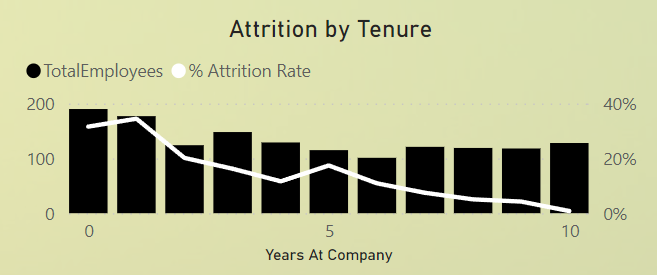
In this case study, we analyze the employee data of the fictitious SaaS startup, Azure.Inc, as well as their annual performance review data. The objective is to uncover factors that influence attrition – a pressing challenge that organizations constantly grapple with. Leveraging this newfound understanding, we have subsequently developed a comprehensive employee performance tracker to assist managers in assessing performance more effectively and detecting potential attrition risks early on. Please follow along on the Power BI dashboard as we go through the key findings.
Job Titles with the Highest Attrition
We start off by exploring the overview page that shows the key indicators on attrition. On the lower left corner of the page, we see a table sorting the jobs in the company that see the highest attrition rate. Of all the jobs, the highest turnover are disproportionally located in these three jobs:
- Sales Representative: The high-pressure environment, targets, and perhaps external facing nature of this role may contribute to higher attrition.
- Recruiter: Given the dynamic nature of talent acquisition and its challenges, this role exhibits a significant rate of attrition.
- Data Scientist: As an in-demand job role globally, Data Scientists often have multiple opportunities, which might explain the higher attrition rate.
Other Contributing Factors
As we scroll to the Attrition page, we see three additional factors that exacerbates attrition.
1.Tenure

This indicates that employees who have been with the company for more extended periods tend to stay longer, suggesting the importance of employee retention strategies in the early years of tenure.
There’s a noticeable inverse relationship between the years of tenure and attrition rates.
2. Travel
Employees who travel frequently for business purposes showed a higher propensity to leave. This could be attributed to the stress and strain frequent travel can put on work-life balance and personal commitments.
3. Over Time
20
More likely to leave if working over time
Solution
Employee Performance Tracker
By aggregating major influencing factors on attrition, combined with performance review data, managers can efficiently use the Performance Tracker to identify employees who are at risk of leaving. Giving them an opportunity to alleviate employee concerns and retain valuable talents.
Capitalizing on these insights, we’ve introduced an ‘Employee Performance Tracker’. This tool allows managers to:
Monitor Performance: Assess how each employee fares in their role, identify areas of improvement, and offer targeted interventions or training.
Detect Attrition Risks: With built-in analytics, the tracker alerts managers about potential attrition risks, offering them a window of opportunity to address concerns and retain valuable talent.
Closing Note
Understanding employee behaviors and patterns is paramount to ensuring a productive and harmonious work environment. By acting on the insights drawn from our analysis and employing tools like the Employee Performance Tracker, we can foster a more engaged, satisfied, and loyal workforce.
By adopting proactive strategies and leveraging data-driven insights, we’re better positioned to address the challenges of attrition and build a robust, resilient workforce for the future.






